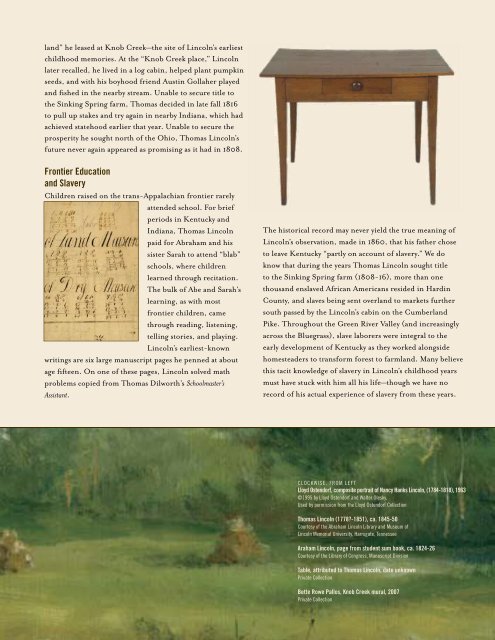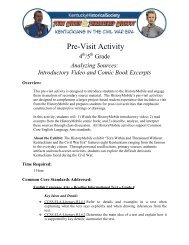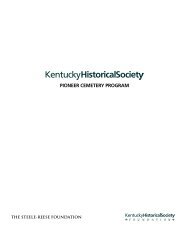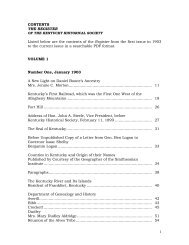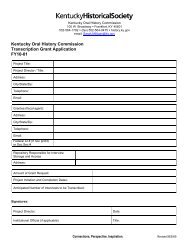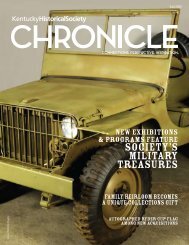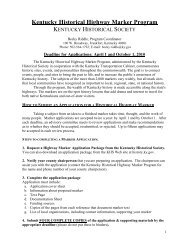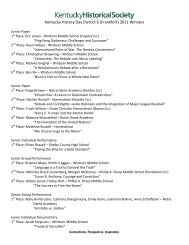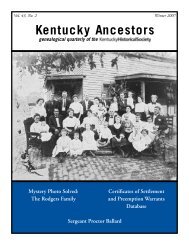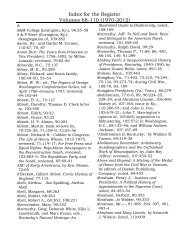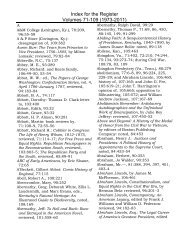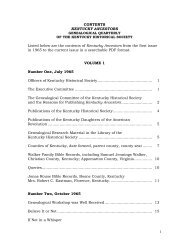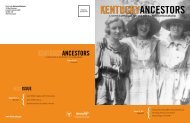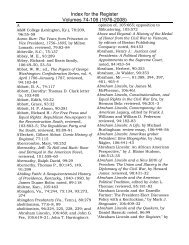Chronicle Fall 2008 Lincoln insert - Kentucky Historical Society
Chronicle Fall 2008 Lincoln insert - Kentucky Historical Society
Chronicle Fall 2008 Lincoln insert - Kentucky Historical Society
You also want an ePaper? Increase the reach of your titles
YUMPU automatically turns print PDFs into web optimized ePapers that Google loves.
land” he leased at Knob Creek—the site of <strong>Lincoln</strong>’s earliest<br />
childhood memories. At the “Knob Creek place,” <strong>Lincoln</strong><br />
later recalled, he lived in a log cabin, helped plant pumpkin<br />
seeds, and with his boyhood friend Austin Gollaher played<br />
and fished in the nearby stream. Unable to secure title to<br />
the Sinking Spring farm, Thomas decided in late fall 1816<br />
to pull up stakes and try again in nearby Indiana, which had<br />
achieved statehood earlier that year. Unable to secure the<br />
prosperity he sought north of the Ohio, Thomas <strong>Lincoln</strong>’s<br />
future never again appeared as promising as it had in 1808.<br />
Frontier Education<br />
and Slavery<br />
Children raised on the trans-Appalachian frontier rarely<br />
attended school. For brief<br />
periods in <strong>Kentucky</strong> and<br />
Indiana, Thomas <strong>Lincoln</strong><br />
paid for Abraham and his<br />
sister Sarah to attend “blab”<br />
schools, where children<br />
learned through recitation.<br />
The bulk of Abe and Sarah’s<br />
learning, as with most<br />
frontier children, came<br />
through reading, listening,<br />
telling stories, and playing.<br />
<strong>Lincoln</strong>’s earliest-known<br />
writings are six large manuscript pages he penned at about<br />
age fifteen. On one of these pages, <strong>Lincoln</strong> solved math<br />
problems copied from Thomas Dilworth’s Schoolmaster’s<br />
Assistant.<br />
The historical record may never yield the true meaning of<br />
<strong>Lincoln</strong>’s observation, made in 1860, that his father chose<br />
to leave <strong>Kentucky</strong> “partly on account of slavery.” We do<br />
know that during the years Thomas <strong>Lincoln</strong> sought title<br />
to the Sinking Spring farm (1808-16), more than one<br />
thousand enslaved African Americans resided in Hardin<br />
County, and slaves being sent overland to markets further<br />
south passed by the <strong>Lincoln</strong>’s cabin on the Cumberland<br />
Pike. Throughout the Green River Valley (and increasingly<br />
across the Bluegrass), slave laborers were integral to the<br />
early development of <strong>Kentucky</strong> as they worked alongside<br />
homesteaders to transform forest to farmland. Many believe<br />
this tacit knowledge of slavery in <strong>Lincoln</strong>’s childhood years<br />
must have stuck with him all his life—though we have no<br />
record of his actual experience of slavery from these years.<br />
CLOCKWISE, FROM LEFT<br />
Lloyd Ostendorf, composite portrait of Nancy Hanks <strong>Lincoln</strong>, (1784-1818), 1963<br />
©1995 by Lloyd Ostendorf and Walter Olesky.<br />
Used by permission from the Lloyd Ostendorf Collection<br />
Thomas <strong>Lincoln</strong> (1778?-1851), ca. 1845-50<br />
Courtesy of the Abraham <strong>Lincoln</strong> Library and Museum of<br />
<strong>Lincoln</strong> Memorial University, Harrogate, Tennessee<br />
Araham <strong>Lincoln</strong>, page from student sum book, ca. 1824-26<br />
Courtesy of the Library of Congress, Manuscript Division<br />
Table, attributed to Thomas <strong>Lincoln</strong>, date unknown<br />
Private Collection<br />
Bette Rowe Pallos, Knob Creek mural, 2007<br />
Private Collection


